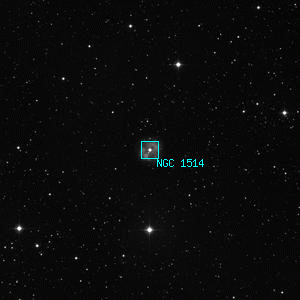NGC 1514

Overlaid DSS image of NGC 1514, 30' x 30' with north at top and west to the right
Aladin viewer for the region around NGC 1514
H IV 69, h 311, BD+30 623, GC 810, HD 281679, SAO 57020, PK 165-15 1, ARO 21, IRAS 04061+3038, GSC 02358-00056, G165.5-15.2, HIP 19395
| Type | Planetary Nebula |
|---|---|
| Magnitude | 9.48 |
| Size | 1.673' x 1.673' @ 90° |
| Right Ascension | 4h 9' 17.0" (2000) |
| Declination | 30° 46' 34" N |
| Constellation | Taurus |
| Description | *9 in neb 3'Diam |
| Classification | sdO+A0/3III |
Observing Notes
Andrew Cooper
Aug 26, 2023 Waikoloa, HI (map)
20cm f/6 Newtonian, Cave Astrola @ 76x
Seeing: 6 Transparency: 7 Moon: 0%
A bright 9th magnitude star with a faint round halo 2' in diameter, faint but obvious, circular with no noted structure or color, a faint star of about 12th magnitude visible 5" south-southeast of the central star (no data in SIMBAD on this second star)
Captain William Henry Smyth
Sep 6, 1837 No. 6 The Crescent, Bedford, England (map)
150mm f/17.6 refractor by Tully 1827
A nebulous star over the Bull's neck, about one quarter the distance of a line between the following portion of the Pleiades and Capella. In the large reflectors this object presents an extraordinary aspect, but with my telescope looks only blurred. It was first registered by ♅. in November, 1790, under this announcement: "A most singular phenomenon; a star 8th magnitude, with a faint luminous atmosphere of a circular form, about 3' in diameter. The star is perfectly in the centre, and the atmosphere is so diluted, faint, and equal throughout, that there can be no surmise of its consisting of stars, nor can there be a doubt of the evident connection between the atmosphere and the star."
From this wonderful aspect ♅. draws the following consequences. Granting the connection between the star and the surrounding nebulosity, if it consist of stars very remote which give the nebulous appearance, the central star, which is visible, must be immensely greater than the rest; or if the central star be no bigger than common, how extremely small and compressed must be those other luminous points which occasion the nebulosity? As, by the former supposition, the luminous central point must far exceed the standard of what we call a star, so, in the latter, the shining matter about the centre will be much too small to come under the same denomination; we therefore either have a central body which is not a star, or a star which is involved in a shining fluid, of a nature totally unknown to us.
♅. maintained at first, that all nebula were stellar masses; but it will be obvious to those who have studied Sir William's condensation system, after the palinody of 1791, that he adopted the last opinion on further experience. This luminous matter seems more fit to produce a star by its condensation, than to depend on the star for its existence; but, after all, it may be, that the star happens to fall in a line with the centre of the nebula, so as to be connected optically but not physically. See 19 ♅. VI., RA 15h 8m [NGC 5897].― A Cycle of Celestial Objects Vol II, The Bedford Catalogue, William Henry Smyth, 1844
William Herschel
Nov 13, 1790 Observatory House, Slough (map)
A most singular phenomenon! A star of about 8th magnitude with a faint luminous atmosphere, of circular form, and about 3 minutes in diameter. The star is perfectly in the center and the atmosphere is so delicate, faint and equally throughout that there can be no surmise of its consisting of stars; nor can there be a doubt of the evident connection between the atmosphere and the star. Another star, not much less in brightness and in the same field as the above, was perfectly free from any such appearance.
Other Data Sources for NGC 1514
Nearby objects for NGC 1514
1 object found within 120'
| Psi Tauri |
Credits...
Drawings, descriptions, and CCD photos are copyright Andrew Cooper unless otherwise noted, no usage without permission.
A complete list of credits and sources can be found on the about page
NGC 1514